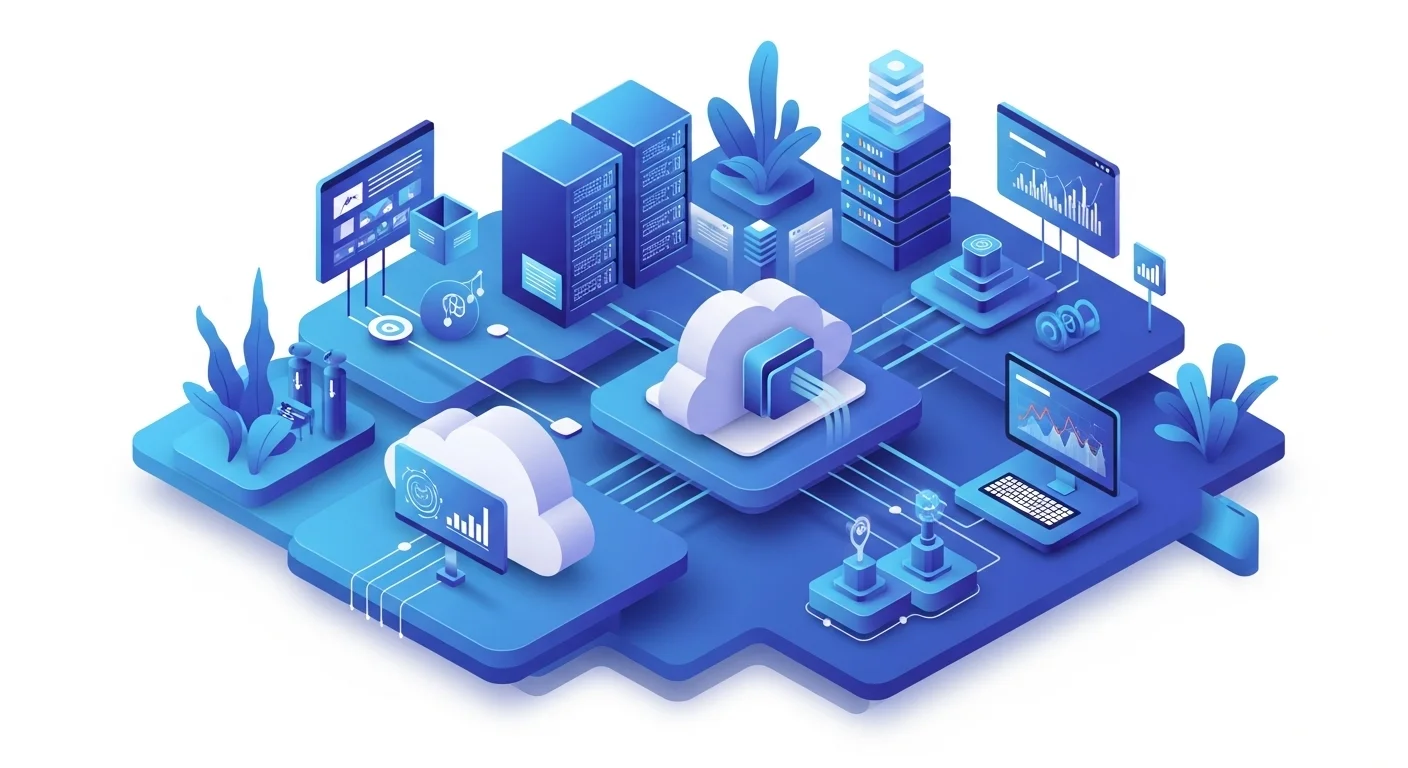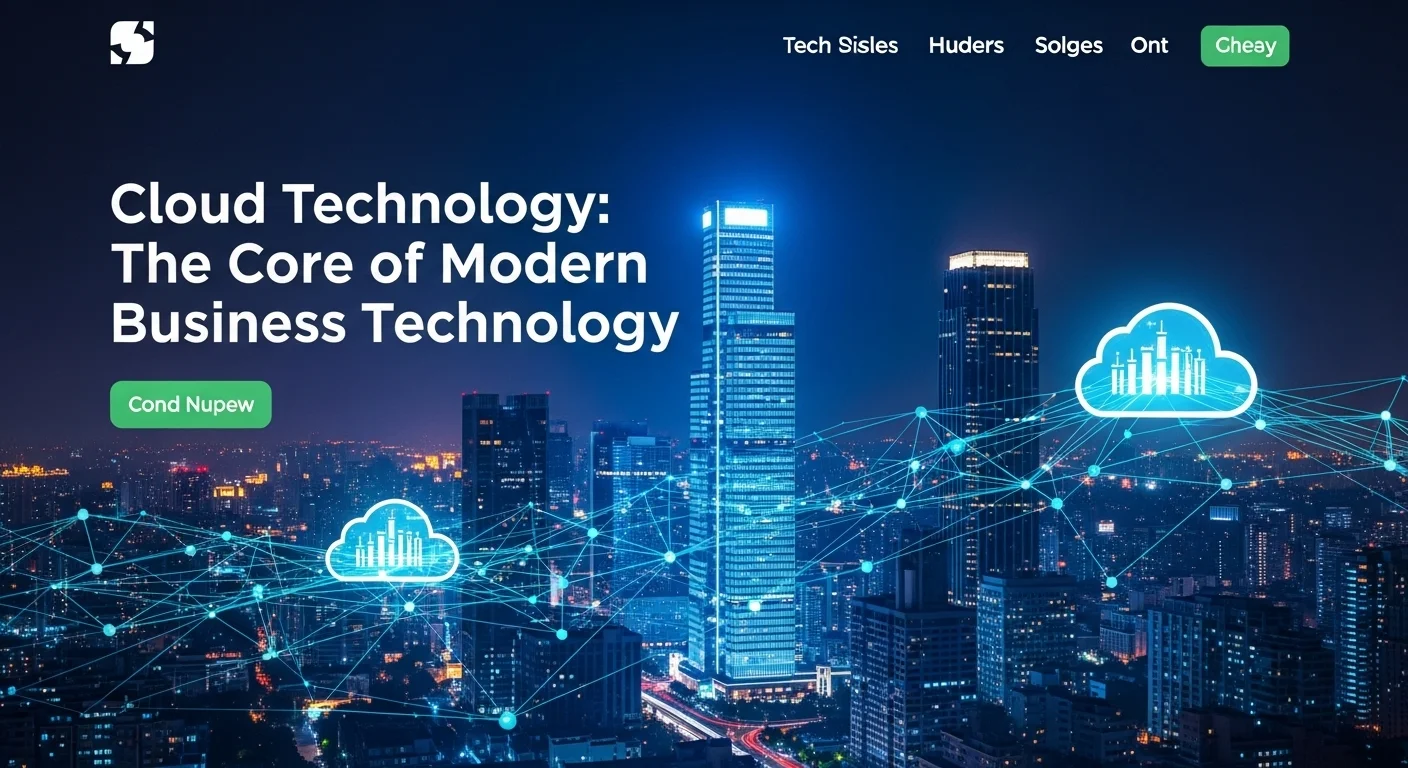Cloud Technology Explained: A Personal Guide to Powering Your Business

Executive Summary
In my years as a cloud solutions architect, I've seen 'the cloud' go from a buzzword to the absolute backbone of modern business. It's not just about storing files online; it's about a complete shift in how we build, innovate, and scale. This technology has leveled the playing field, giving small startups the same power as giant corporations. This guide is my way of cutting through the jargon. We'll explore what the cloud really is, from the core services like IaaS, PaaS, and SaaS to the strategies—public, private, and hybrid—that make it all work. I want to show you how moving to the cloud isn't just an IT project, but a strategic move that unlocks incredible efficiency, agility, and the power to use cutting-edge tools like AI. For anyone in tech, understanding this is no longer optional. This is your starting point for mastering the most transformative technology of our time.
Table of Contents
Table of Contents
- What is Cloud Technology, Really?
- The Building Blocks: Service and Deployment Models
- The Real-World Wins: Business Benefits of the Cloud
What is Cloud Technology, Really?
In a world where digital is king, the cloud is the kingdom. But what is it? I like to explain it like this: think of it as electricity. You don't build your own power plant to turn on the lights; you just plug into a grid and pay for what you use. Cloud Technology is the exact same idea, but for computing power. Instead of buying and maintaining expensive servers in your office, you access everything you need—storage, databases, software, and even advanced intelligence—over the internet from a provider like Amazon Web Services (AWS), Microsoft Azure, or Google Cloud. You pay for what you use, making powerful technology accessible and affordable. [2, 5]
The importance of this shift can't be overstated. I've seen firsthand how it has completely democratized technology. [4] A startup with a great idea can launch a global service overnight without a million-dollar investment in hardware. [5] Large companies can finally break free from clunky, old systems and innovate at a speed they never thought possible. The cloud is the silent engine behind the streaming services you watch, the social media you scroll through, and the incredible advances in AI and data analysis that are changing our world. [12] Without it, the way we work, connect, and innovate today would simply not exist.
The Building Blocks: Service and Deployment Models
To really get a handle on the cloud, you need to know its basic models. Think of these as different levels of service, depending on how much you want to manage yourself.
1. Infrastructure as a Service (IaaS): This is the most fundamental level. You're essentially renting the raw computing hardware—virtual servers, storage, networking—from a provider. [2, 28] It’s like leasing a plot of land. You get the space, but you're responsible for building the house (installing the operating system, software, etc.). It offers the most control and is perfect for companies that want to move their existing infrastructure to the cloud with minimal changes. Using Azure Virtual Machines or Amazon EC2 is a classic IaaS scenario.
2. Platform as a Service (PaaS): PaaS takes it a step further. The provider manages the hardware *and* the operating system. All you do is build and run your applications. [28] To use our analogy, this is like renting a fully equipped workshop. You don't have to worry about the tools or the building maintenance; you can just focus on your craft. This is a dream for developers, as it dramatically speeds up the creation of new apps. Services like Google App Engine or the fantastic tools in the Azure cloud technologies suite, like Azure App Service, are great examples.
3. Software as a Service (SaaS): You use this every day. SaaS is software that's delivered over the internet on a subscription basis. [17] The provider handles everything—the hardware, the software, the updates. [17] Think of Google Workspace, Microsoft 365, or Salesforce. You just log in through your browser and use it. It’s like getting your coffee from a café instead of buying an espresso machine. It's the simplest way to use the power of the cloud.
Along with these services, you choose *how* they are deployed:
Public Cloud: This is the most common model. The infrastructure is owned by a provider like Microsoft Azure and shared by multiple organizations over the internet. It offers massive scale and cost-effectiveness. [2]
Private Cloud: These are resources used exclusively by one organization. The infrastructure can be in your own data center or hosted by a third party, but it's entirely dedicated to you. This offers maximum control and security, which is vital for industries with strict regulations. [2]
Hybrid Cloud Technology: This is the sweet spot for many businesses. A hybrid cloud technology approach combines public and private clouds, letting you share data and applications between them. [6] I've helped many clients use this model to keep sensitive data in their private cloud while using the public cloud's power for tasks like web hosting or development. It offers the best of both worlds: security and scalability. [6, 9]
The Real-World Wins: Business Benefits of the Cloud
Adopting cloud based technology is one of the smartest strategic moves a business can make today. Here are the benefits I see clients achieve time and time again:
Serious Cost Savings: You stop spending huge amounts of money on hardware and the staff to maintain it. Instead, you have a predictable monthly operating cost. It’s a shift from a massive capital expense (CapEx) to a manageable operational expense (OpEx). [2, 31]
Scale on Demand: Remember when a website would crash because it went viral? The cloud's elasticity solves that. You can automatically scale your resources up to handle a massive traffic spike and then scale back down when things quiet down. You only pay for the power you need, when you need it. [5]
Move Faster: In the old days, getting a new server could take weeks. In the cloud, it takes minutes. This incredible speed allows your teams to experiment, develop, and launch new ideas faster than the competition. [4]
Go Global in Clicks: Top cloud technology services have data centers all over the world. [4] You can deploy your application close to your customers, wherever they are, reducing lag and providing a better experience for everyone.
Bulletproof Security: Early on, people worried about cloud security. Now, it's a major reason to switch. Providers like Microsoft invest billions in security, far more than a single company ever could. With Azure cloud technologies, you get world-class, multi-layered security and an army of experts working to protect your data. [19]
Better Disaster Recovery: The cloud makes backing up data and planning for disasters simpler and cheaper. Your data can be mirrored across multiple locations, ensuring that if one goes down, your business keeps running without a hitch. [22]
The world of IT is always changing, but right now, innovations like serverless computing and the seamless integration of AI are making the cloud more powerful than ever. Understanding these fundamentals is the first step to harnessing this power for yourself.

Your Complete Guide to Cloud Strategy and Business Solutions
Getting into Cloud Technology is one thing, but truly mastering it is another. It's about moving beyond the basics and developing a smart strategy that aligns with your business goals. This is where my experience comes in. I’ve guided countless businesses through this journey, from their first migration to optimizing every last dollar and security setting. This isn't just a technical manual; it's a strategic guide. Whether you're a brand new company born in the cloud or an established player looking to modernize, the goal is the same: use this amazing technology to innovate, grow, and win.
Cloud Migration: Your Roadmap to the Cloud
Moving to the cloud isn't just a 'copy and paste' job. It's a major project that requires a clear plan. The '6 R's' framework is a fantastic way to think about this, and it's a checklist I use with every client:
1. Rehosting (aka 'Lift and Shift'): This is the simplest path. You take an application as-is and move it to a cloud IaaS platform. It’s fast and easy, but it's like moving into a new house without redecorating—you don't get all the new benefits.
2. Replatforming ('Lift and Reshape'): Here, you make a few smart tweaks during the move to get some quick wins. A common one I recommend is moving a database to a managed cloud service like Azure SQL. You instantly offload the maintenance headache and often get better performance.
3. Repurchasing ('Drop and Shop'): Sometimes, it's better to just move to a new solution. This means ditching a clunky, old on-premise system for a modern SaaS alternative like Salesforce. It completely removes the burden of managing the software and infrastructure.
4. Refactoring / Re-architecting: This is the most intensive option, but it offers the biggest payoff. You rebuild your application to take full advantage of cloud-native features, like breaking it into microservices. It's a big project, but it results in maximum performance, scalability, and agility.
5. Retiring: As you review everything, you'll find applications that are no longer being used. Turning them off seems obvious, but it's amazing how much money this can save. It frees up resources for what really matters.
6. Retaining: Sometimes, it makes sense to keep an application on-premise, maybe for compliance reasons or because it's just too complex to move right now. This is where a hybrid cloud technology strategy becomes crucial, allowing you to seamlessly connect what you keep with what you move.
Comparing the Titans: AWS vs. Azure vs. GCP
The public cloud is dominated by three giants. Choosing the right one depends on your needs. Here’s my personal take:
Amazon Web Services (AWS): The original pioneer. AWS has the widest range of services and the largest market share. [21] It's incredibly mature and reliable. I often recommend it to startups and companies that want the biggest toolbox available. The community support is massive, so you can almost always find an answer to your question.
Microsoft Azure: Azure is a powerhouse, especially in the corporate world. [15] Its biggest advantage is how perfectly it integrates with other Microsoft products like Office 365 and Active Directory. If your company already runs on Microsoft, Azure is often a no-brainer. They are also, in my opinion, leaders in the hybrid cloud technology space with tools like Azure Arc. [6, 35]
Google Cloud Platform (GCP): GCP's DNA comes from Google itself, so it excels at data, AI, machine learning, and networking. [21] I point data-heavy businesses toward GCP. If your business lives and breathes data analytics, GCP's tools like BigQuery are hard to beat. They are also very strong in the world of containers with Kubernetes, which they originally developed.
| Feature | AWS | Microsoft Azure | Google Cloud Platform (GCP) |
|---|---|---|---|
| Market Position | The Leader, most mature platform | #2, dominant in the enterprise | #3, a leader in data & AI |
| Best For | Broad use cases, startups | Companies using Microsoft products, hybrid | Data-intensive apps, machine learning |
| My Take | The reliable, go-to choice | The seamless enterprise integration | The data and analytics powerhouse |
Cloud Governance: Staying Secure and on Budget
The cloud gives you incredible power, but you need to manage it wisely. The two pillars of good cloud governance are security and cost management.
Cloud Security: Security is a team effort. The provider secures the 'cloud' (their physical data centers), but you are responsible for security 'in the cloud' (your data, access, and applications). It's like renting an apartment: the landlord provides a secure building, but you still have to lock your own door. Key practices are:
- Identity and Access Management (IAM): Tightly control who has access to what. Always give people the minimum level of permission they need to do their job.
- Data Encryption: Encrypt your data when it's stored and when it's moving across the network. This is non-negotiable for sensitive information.
- Network Security: Use virtual networks and firewalls to wall off your resources and control who can talk to them.
- Compliance: Lean on your provider's certifications (like GDPR, HIPAA, etc.). Azure cloud technologies, for example, have great dashboards to help you manage your compliance requirements. [19]
Cost Management (FinOps): The pay-as-you-go model can lead to surprise bills if you're not careful. FinOps is a new way of thinking that brings financial discipline to the cloud. [25, 33] The core ideas are:
- See Everything: Use tools like Azure Cost Management to see exactly where your money is going. Tagging resources by project or team is essential for this. [33]
- Optimize Your Spend: Constantly look for savings. This could mean choosing the right size server for a task, prepaying for predictable workloads to get a discount, or simply shutting down test environments over the weekend.
- Forecast Your Budget: Get good at predicting your future cloud spend so you can budget accurately and avoid shocks.
Your journey with cloud based technology is ongoing. By mastering migration, choosing the right cloud technology services, and governing your environment with a firm hand on security and costs, you can truly transform your business.

Advanced Tips and Strategies to Master Cloud Technology
Once you're comfortable with the basics of Cloud Technology, it's time to start thinking like a pro. This means moving beyond just 'using' the cloud and starting to 'leverage' it for a real competitive edge. It’s about building a culture of continuous improvement, adopting powerful new tools, and staying ahead of the curve. In this final section, I'll share some of the most impactful strategies and practical tools I recommend to clients to elevate their tech experience from good to truly game-changing.
Best Practices for World-Class Cloud Management
Strong management is what separates a chaotic cloud environment from a well-oiled machine. It’s the foundation that ensures security, controls costs, and keeps everything aligned with your business goals.
1. Form a Cloud Center of Excellence (CCoE): This sounds corporate, but the idea is simple: get a small, dedicated team of people from IT, finance, and security to set the rules of the road for your cloud usage. This team becomes the go-to source of knowledge, creating smart policies for things like security standards and cost tracking, ensuring everyone is on the same page.
2. Automate Everything You Can: Automation is your best friend in the cloud. Use 'Infrastructure as Code' (IaC) tools like Terraform or Azure Resource Manager templates to define your entire setup in code. This makes your deployments consistent, repeatable, and far less prone to human error. Plus, you can track changes to your infrastructure just like you do with software code. Automation should be your default for everything from security checks to cost-saving scripts.
3. Master Your Tagging Strategy: In a big environment, resources can get lost in the shuffle. A strict tagging strategy is crucial. By tagging every resource with information like its owner, project, or cost center, you gain crystal-clear visibility. This data is pure gold for managing costs and understanding what's actually being used.
4. Be Proactive with Security Monitoring: Don't wait for a breach to happen. Use continuous monitoring tools like Azure Sentinel or AWS GuardDuty. These services use AI to spot suspicious activity and potential threats in real-time, often fixing them automatically. Think of it as a 24/7 security guard for your cloud environment.
Leveraging Emerging Tech for a Competitive Edge
The cloud is where innovation happens first. Keeping an eye on what's next can give you a massive advantage. [25] Here are the technologies I'm most excited about right now:
1. Serverless Computing (FaaS): This is a revolution for developers. Serverless lets you run your code without thinking about servers at all. [38] You just provide the code as a 'function', and the cloud provider handles all the scaling and availability automatically. You only pay for the exact moment your code is running. It's incredibly efficient for event-driven tasks and is a core part of modern application design. Services like AWS Lambda and Azure Functions are leading this charge. [13, 37]
2. Containers and Kubernetes: Containers (like Docker) bundle an application and all its dependencies into a single, portable package. [33] This guarantees it will run the same way everywhere. Kubernetes is the 'conductor' that manages all these containers at scale, automating deployment and recovery. [25] This combination has become the gold standard for building modern, resilient applications, especially in a hybrid cloud technology setup.
3. AI and Machine Learning as a Service: The cloud has made AI and ML accessible to everyone, not just data scientists with supercomputers. [29] You can now add powerful capabilities like image recognition or language translation to your app with a simple API call. For more custom work, platforms like Amazon SageMaker or Azure Machine Learning give you all the tools you need to build, train, and deploy your own unique models. This is where truly intelligent applications are being born. [37]
4. Edge Computing: Edge computing brings the power of the cloud closer to where data is created. [37] Instead of sending everything to a central data center, you process data 'at the edge'—on a factory floor, in a retail store, or in a car. This is essential for applications needing split-second responses, like self-driving cars or real-time industrial monitors. The edge and the cloud work together, with the edge handling immediate tasks and the cloud managing the heavy-duty analysis.
Practical Tools and Quality Resources
To put this all into action, you need the right tools. If you're in the Microsoft world, I highly recommend digging deep into the Azure cloud technologies portfolio. Go beyond the basics and explore:
- Azure DevOps: A fantastic suite of tools for automating your entire software delivery pipeline, from code to deployment.
- Azure Sentinel: A cloud-native security information and event management (SIEM) tool that uses AI to hunt for threats across your enterprise.
- Azure Arc: The heart of Microsoft's hybrid cloud technology vision. It lets you manage resources anywhere—in your data center, at the edge, or even on other clouds like AWS—all from a single control panel.
Finally, never stop learning. A resource I constantly recommend, even to people not using AWS, is the AWS Well-Architected Framework. Its core pillars—Operational Excellence, Security, Reliability, Performance, and Cost Optimization—are universal principles for building great systems in any cloud. By embracing these practices and leveraging the incredible cloud technology services available, you can build a tech strategy that doesn't just support your business, but actively drives it forward.
Expert Reviews & Testimonials
Sarah Johnson, Business Owner ⭐⭐⭐
This was a good overview, but as a small business owner, I was hoping for more step-by-step examples of how to apply this. It felt a little high-level for someone just starting out.
Mike Chen, IT Consultant ⭐⭐⭐⭐
A solid article that covers the key cloud concepts well. I'd share this with clients who need a primer. Could benefit from a slightly simpler explanation of the more technical topics like Kubernetes, but overall very helpful.
Emma Davis, Tech Expert ⭐⭐⭐⭐⭐
Finally, an article that explains the cloud without being overly technical or too simplistic! This is a fantastic resource that I'll be saving. The comparison of the big three providers was especially clear and useful. Great job.



